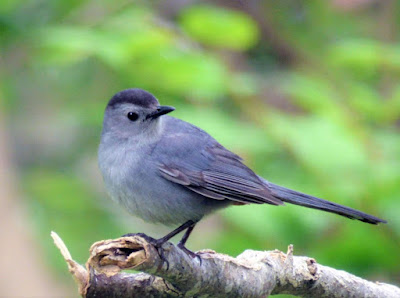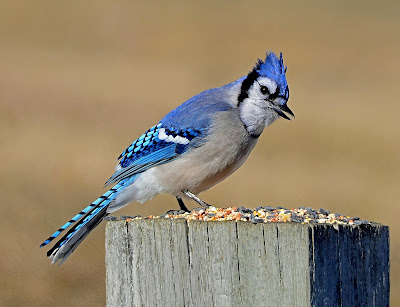Catbirds: sounds like a cat but doesn't look like a cat
Catbirds: sounds like a cat but doesn't look like a cat
 |
| Catbirds are plentiful in New England [Sue Pike photo] |
I was walking down my street, minding my own business, when a mid-sized gray bird flew into the bushes. Instead of disappearing into the shrubbery it hopped out onto a fairly prominent branch and watched me as I watched it. It didn’t fly away, it didn’t run for cover, it just watched me until I walked away up the street. This is typical behavior for gray catbirds - they are inquisitive, vocal birds who don’t seem to mind being around people.
Most of my favorite birds are ones whose songs I can identify. The catbird, one of my favorites, is no exception to this rule. They are mimics (related to mockingbirds) - warbling out a jumbled mix of other bird songs along with their most identifiable song, a downward slurring mew - sounds very much like a cat, hence the name. The other common mimic we have around here is the mockingbird - you can distinguish their song from a catbirds’ because a mockingbird’s is more orderly. They’ll also run through a bunch of other bird songs in a stately, logical progression with consistent repeats - not so the catbird.
Another of my personal criteria for favorite among birds is subtlety of plumage. I love the understated beauty of a female cardinal or cedar waxwing, the inky black of a crow or the slate gray of a catbird. Both males and females are mostly gray with a dark black cap and some rust under the tail. You really can’t confuse them with any other bird - they are the only North American bird with uniform gray plumage.
These are very vocal birds. According to the Cornell Lab for Ornithology the calls we most commonly hear are those of the males. “Male Gray Catbirds sing a long, halting series of short notes collected into ‘phrases,’ which combine to make a song. One whole song can last many minutes (some songs have been recorded that lasted over 10 minutes). Females sing infrequently and when they do they are much more quiet about it.”
If you like catbirds and want to attract them to your yard make sure to provide thickets - that’s their favorite nesting habitat. Humans often provide this when we cut down forests and let tangles of shrubs and vines proliferate at the edges of our lawns and roadsides. This is one reason catbirds do so well around us.
You can also provide fruit - catbirds love all kinds of fruit, from wild berries to cultivated fruit. They can even become a pest and destroy crops. I like to put out raisins, catbirds really, really love soaked raisins, but most any kind of fruit will do. That said, in the summer, the young nestlings are fed almost entirely on insects (Audubon.com), so those raisins are most likely adult fare. According to the Audubon Guide to North American Birds, adults eat mostly vegetable matter but will also sometimes catch small fish--I’m not sure how they do that. The Audubon Guide goes on to say that catbirds eat “a bizarre assortment of items including doughnuts, cheese, boiled potato and corn flakes” I wonder if this kind of diet is as bad for them as it is for us?
One final thing I love about catbirds is their intelligence. One fairly common bird in these parts is the brown-headed cowbird, this bird practices brood parasitism - meaning it lays its eggs in the nests of other birds and lets these other birds raise their young. Catbirds are too smart for this. When cowbirds try laying their eggs in a catbird’s’ nest, the eggs are usually punctured and thrown out by the canny catbirds.
Catbirds are one of those birds that I tend to overlook because they are so common - “Common as the grass” Mary Oliver says in her poem “Catbird.” And they are. Their numbers are stable in New England, they do well with humans, they are common. But that doesn’t make them less than beautiful.



Comments
Post a Comment